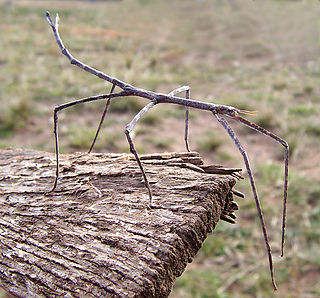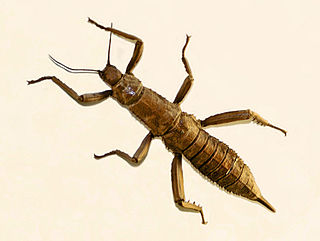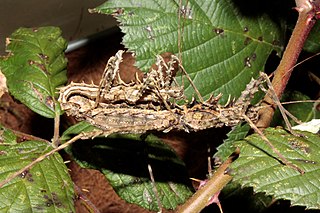
The Phasmatodea are an order of insects whose members are variously known as stick insects, stick-bugs, walkingsticks, stick animals, or bug sticks. They are also occasionally referred to as Devil's darning needles, although this name is shared by both dragonflies and crane flies. They can be generally referred to as phasmatodeans, phasmids, or ghost insects, with phasmids in the family Phylliidae called leaf insects, leaf-bugs, walking leaves, or bug leaves. The group's name is derived from the Ancient Greek φάσμα phasma, meaning an apparition or phantom, referring to their resemblance to vegetation while in fact being animals. Their natural camouflage makes them difficult for predators to detect; still, many species have one of several secondary lines of defense in the form of startle displays, spines or toxic secretions. Stick insects from the genera Phryganistria, Ctenomorpha, and Phobaeticus include the world's longest insects.

The Euphasmatodea, also known by its junior synonym Verophasmatodea is a suborder of the Phasmatodea, which contains the vast majority of the extant species of stick and leaf insects, excluding the Timematodea. The oldest record of Euphasmatodea is Araripephasma from the Crato Formation of Brazil, dating to the Aptian stage of the Early Cretaceous.

Argosarchus is a monotypic genus in the family Phasmatidae containing the single species Argosarchus horridus, or the New Zealand bristly stick insect, a stick insect endemic to New Zealand. The name "horridus" means bristly in Latin, likely referring to its spiny thorax.

The Phasmatidae are a family of the stick insects. They belong to the superfamily Anareolatae of suborder Verophasmatodea.

Ctenomorpha marginipennis, the margin-winged stick insect, is a species of stick insect endemic to southern Australia. The species was first described by George Robert Gray in 1833.

Pulchriphyllium giganteum, commonly known as the Giant Malaysian Leaf insect, is a species of leaf insects described from Malaysia by Hausleithner in 1984 and placed in the genus Pulchriphyllium since 2021. Pulchriphyllium giganteum is the largest species belonging to the genus Pulchriphyllium reaching 105 mm in size. They are found most abundantly in the west Malaysian tropics. The females typically have large elytra that lie edge to edge on the abdomen and tend to lack hind wings making them usually flightless. Males have small elytra and sometimes transparent non-leaflike functional hind wings. Pulchriphyllium giganteum found in the wild tend to be mostly females and the first male of this species was not found until 1994. In captivity, the species has primarily been observed to reproduce through parthenogenesis meaning the females are asexual. The primary reproductive pattern in the wild is unknown. Eggs tend to be brown or black and glossy and resemble seeds. They hatch around 6 months after breeding. Newly hatched young nymphs tend to be wingless and brown or reddish in color. They develop their green color after feeding on leaves. Both the adult and larval stages are phytophagous meaning they feed on plants. The main plant food sources for this species are oak and bramble tree leaves.

Bacillidae is a stick insect family in the order Phasmatodea and the suborder Verophasmatodea.

Clonopsis is a stick insect genus in the family Bacillidae. Species have been recorded from mainland Europe and North Africa.

Eurycantha is a genus of Australasian stick insects: typical of the tribe Eurycanthini. It was described by Jean Baptiste Boisduval in 1835.
Lobofemora is a genus of stick insects in the subfamily Clitumninae. Species have known distributions from National Parks in Vietnam.

The Gratidiini are a tribe of stick insects based on the type genus Clonaria and first used by Cliquennois in 2005. Genera are known to be distributed in: Africa, Europe, temperate and tropical Asia and various Pacific Islands.
Lobofemora scheirei is a species of stick insects in the tribe Clitumnini. This species was found in the seasonal tropical forests of the Dong Nai Biosphere Reserve, which includes Cát Tiên National Park, Vietnam. It is named after the Belgian comedian, TV host and self-declared nerd Lieven Scheire.

Paramenexenus is a genus of Asian stick insects belonging to the family Lonchodidae, erected by Josef Redtenbacher in 1908.
Pseudodiacantha is an Asian genus of stick insects in the family Lonchodidae and subfamily Necrosciinae. Members of Pseudodiacantha are excellent examples of camouflage, as they are known to cover themselves in mossy or lichenous outgrowths that supplement their disguise.

Brockphasma is currently a monotypic genus of Asian stick insects in the tribe Necrosciini, erected by G.W.C. Ho, Liu, Bresseel & Constant in 2014. To date, one species has been recorded from Vietnam.

Nuichua is a genus of Asian stick insects in the tribe Necrosciini, erected by J Bresseel and J Constant, in 2018. To date (2022) the sole species has been recorded from Vietnam.
Neooxyartes is a monotypic genus of Asian stick insects in the tribe Necrosciini, erected by G.W.C. Ho in 2018. To date (2022) the sole species has been recorded from Vietnam.

Neohirasea is a genus of stick insects in the tribe Necrosciini, erected by J.A.G. Rehn in 1904. Species has been recorded from temperate and tropical Asia, including: China, India, Japan, Malaysia and Vietnam.
Maculonecroscia is a genus of stick insects in the tribe Necrosciini, erected by F Seow-Choen in 2016. Species distribution records are probably incomplete, but include India, China, Indochina (Vietnam) and west Malesia.













